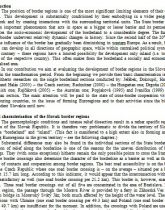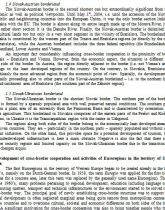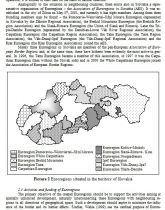Hľadaj
Zobraz:
Univerzity
Kategórie
Rozšírené vyhľadávanie
45 146
projektov
Vývoj cezhraničnej spolupráce a vytváranie Euroregiónov v Slovenskej republike
| Prípona .doc |
Typ analýza |
Stiahnuté 7 x |
| Veľkosť 0,2 MB |
Jazyk anglický |
ID projektu 9327 |
| Posledná úprava 13.07.2018 |
Zobrazené 4 750 x |
Autor: - |
 Zdieľaj na Facebooku
Zdieľaj na Facebooku |
||
| Detaily projektu | ||
- cena:
16 Kreditov - kvalita:
94,5% -
Stiahni
- Pridaj na porovnanie
- Univerzita:Univerzita Komenského v Bratislave
- Fakulta:Prírodovedecká fakulta
- Kategória:Prírodné vedy » Geografia
- Predmet:Cezhraničná spolupráca
- Študijný program:-
- Ročník:1. ročník
- Formát:MS Office Word (.doc)
- Rozsah A4:11 strán
Development of cross-border cooperation and creating of Euroregions in the Slovak Republic
The position of border regions is one of the most significant limiting elements of their development. This development is substantially conditioned by their embodying in a wider geographic framework and by creating interactions with the surrounding territorial units. The State border represents an important phenomenon that acts in space as a bigger or lesser barrier and its permeability influences the socio-economic development of the borderland to a considerable degree. The function of the border underwent relatively dynamic changes in history. Since the second half of the 20th century, the influence of the border has gradually been diminishing in western Europe. As a result, border regions can develop in all directions of geographic space, while within centralised political systems - on the contrary - these regions have a limited possibility for development only inland (i.e. towards centres of the respective country). This often makes from the borderland a socially and economically marginalised area.
The position of border regions is one of the most significant limiting elements of their development. This development is substantially conditioned by their embodying in a wider geographic framework and by creating interactions with the surrounding territorial units. The State border represents an important phenomenon that acts in space as a bigger or lesser barrier and its permeability influences the socio-economic development of the borderland to a considerable degree. The function of the border underwent relatively dynamic changes in history. Since the second half of the 20th century, the influence of the border has gradually been diminishing in western Europe. As a result, border regions can develop in all directions of geographic space, while within centralised political systems - on the contrary - these regions have a limited possibility for development only inland (i.e. towards centres of the respective country). This often makes from the borderland a socially and economically marginalised area.
Kľúčové slová:
Cross-border co-operation (CBC)
Euroregion
Slovak Republic
Regional self-government
Phare CBC
Interreg
Obsah:
- Introduction
1 Basic characterisation of the Slovak border regions
2 Development of cross-border cooperation and activities of Euroregions in the territory of Slo-vakia
Conclusion
Literature
Zdroje:
- DRGOŇA, V. (2001): Transformačný proces a jeho vplyv na regionálnu štruktúru Slovenska. Univerzita Konštantína Filozofa Nitra, 138 pp. ISBN 80-8050-453-9.
- HALÁS, M. (2005): Cezhraničné väzby, cezhraničná spolupráca (na príklade slovensko-českého pohraničia s dôrazom na jeho slovenskú časť). Univerzita Komenského v Bratislave, 152 pp. ISBN 80-223-2054-4.
- IVANIČKA, K. (1999): Slovensko - Génius loci. Eurostav, Bratislava, 157 pp. ISBN 80-968183-3-3.
- JEŘÁBEK, M. (2000): Pohraničí, přeshraniční spolupráce a euroregiony - evropský pohled a situace v Česku. Geografické rozhledy, Vol. 10, No. 1, p. 6-7.
- JEŘÁBEK, M., DOKOUPIL, J., HAVLÍČEK, T. (2004): České pohraničí - bariéra nebo prostor zprostředkování? Academia, Praha, 304 pp. ISBN 80-200-1051-3.
- JIROUSEK, J. (2004): Euroregiony na Slovensku. Institut pro evropskou politiku. Online [Cite 12. 4. 2004]. Getatable in internet: < http://www.europeum.org >.
- MARHULÍKOVÁ, O. (2005): Inštitucionálne aspekty cezhraničnej spolupráce v Slovenskej republike. Rada Európy, Ministerstvo vnútra SR, Bratislava, 182 pp. ISBN 80-89051-06-5.
- POPJAKOVÁ, D. (1995): Institutionalization and organizational shapes of transfrontier cooperation. In: Acta UMB; Geographical Studies No. 1. The Boundaries and Their Impact on the Territorial Structure of Region and State. Banská Bystrica, p. 46-49.
- RAJČÁKOVÁ, E. (2005): Regionálny rozvoj a regionálna politika. Univerzita Komenského v Bratislave, 120 pp. ISBN 80-223-2038-2.
- RECHNITZER, J. (2000): The features of the transition of Hungary´regional system. Centre for regional studies, Pécs, 74 pp. ISBN 963-04-7339-9.
- ŠINDLER, P., WAHLA, A. (1999): Evropská Unie v geografickém vzdělávání. Přírodovědecká fakulta Ostravské univerzity, 105 pp. ISBN 80-7042-780-9.
- WEINBERGER, O. (1995): Inštitucionalizmus. Nová teória konania, práva a demokracie. Archa, Bratislava, 240 pp. ISBN 80-7115-102-5.
- ZEMKO, I., BUČEK, J. (2000): Problémy cezhraničnej spolupráce a jej inštitucionálneho rámca na príklade regiónu Bratislavy. In: Geographical spectrum 2. Geo-grafika, Univerzita Komenského v Bratislave, p. 43-54.







